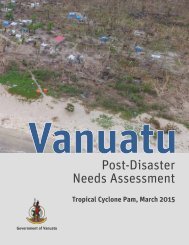Fiji
yqgk302EGjo
yqgk302EGjo
Create successful ePaper yourself
Turn your PDF publications into a flip-book with our unique Google optimized e-Paper software.
FIJI Post-Disaster Needs Assessment<br />
The distribution of losses (F$ million) for each division is shown in Figure 33.<br />
300<br />
250<br />
Losses (F$ million)<br />
200<br />
150<br />
100<br />
50<br />
0<br />
Western Western Western Western<br />
Figure 33: Losses to the Environment Sector by Division<br />
Source: Estimations by Assessment Team.<br />
Native forests Mangrove Coral reefs<br />
Social Impact of Damage and Losses<br />
Damage to the ecosystem and the services it provides is already affecting people (Box 1), and the impacts are likely to<br />
continue for at least a decade. Recovery efforts are aimed at reducing the timeframes of these impacts while supporting<br />
the recovery of ecosystem services and meeting some of the livelihood needs.<br />
Box 1: Damage to Reef: Changing lives and livelihoods of people<br />
The village of Namatala in Ra Province is a small typical coastal village with 24 households and 114 people that rely on fishing for their<br />
protein and cash income. TC Winston brought a lot of changes; the channels used to canoe through are now peppered with one<br />
metre tall “boulders” of coral, deposited by the storm surge generated by the cyclone. One of these boulders is 20m by 3m and has<br />
formed an island of dead coral mixed with shells unknown to people in the village, although they suspect these were lifted from deep<br />
waters. Half of the coral reef that is home to the fish they catch is damaged; coastline that was previously fine sand is now littered with<br />
rocks and coral “boulders”; the deeper waters are shallower; and their two fishing grounds were completely destroyed. The routes<br />
to the fishing areas, which were so well known to the community that they could be traversed at night without fear, have drastically<br />
changed. Following TC Winston, sea cucumbers, eels and other fish lay dead on the beaches, floated on the surface of the water and<br />
were deposited deep into the mangrove areas. The lives and the livelihoods of the people of Namatala village are now very uncertain.<br />
Recovery and Reconstruction Needs for the Environment (F$74 million)<br />
Total needs are estimated at F$73.9 million (Table 68). For effective recovery of environmental assets, a number of activities<br />
that build on ongoing programmes as well as some new ones are proposed and costed. Many of these translate into<br />
additional operational costs, such as those incurred in the management and control of invasive tree species like the African<br />
tulip. To enable coral reefs to rehabilitate and recover for the first two years, pressure on inshore fisheries must be reduced<br />
and interventions like the deployment of FADs will help provide alternative food and protein sources to communities. An<br />
ecological survey of damaged areas (for all environmental assets) and the sustained monitoring of information on the status<br />
of assets in the medium to long term are recommended. The establishment of a government centralized database to<br />
maintain and regularly update information and data is pivotal to recovery efforts and should be supported by community<br />
partners, NGOs and academia, where relevant.<br />
Interventions for clearing debris will differ in cities, villages and agricultural areas, both in terms of methodology and<br />
equipment needed. Special treatment for hazardous wastes is critical and must be supported accordingly.<br />
98 Tropical Cyclone Winston, February 20, 2016



